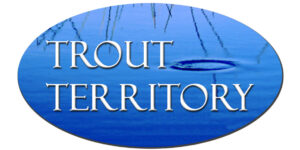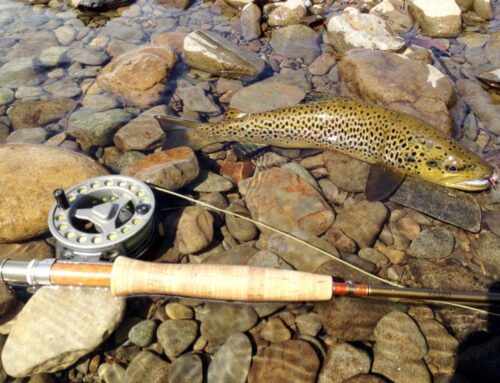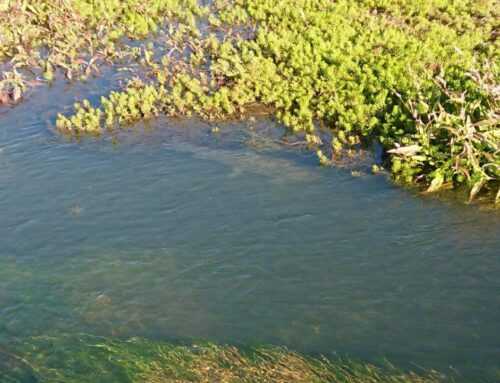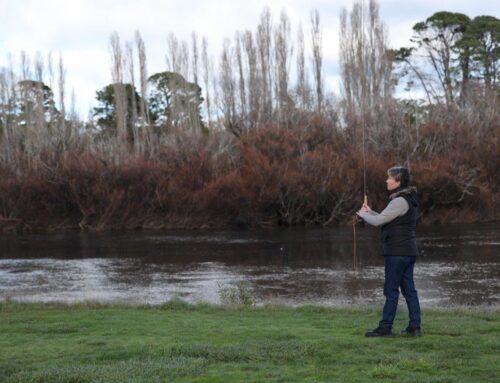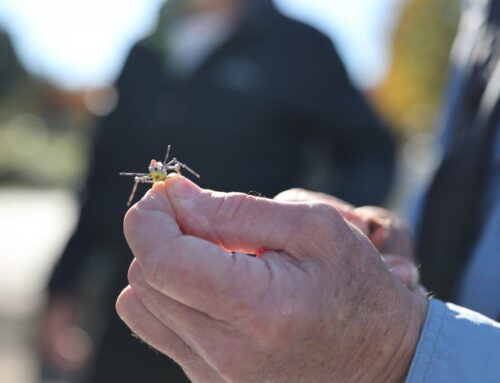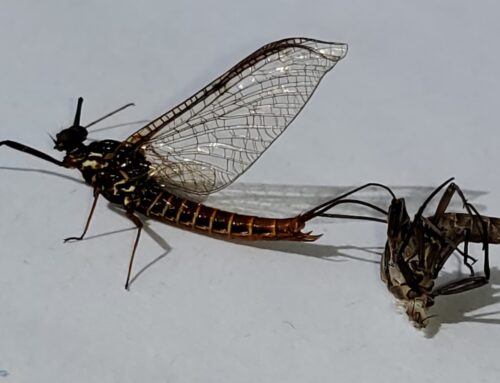How to catch a trout
Trout behaviour, trout food, fly selection
Find the food and you will find the trout. Is the wind pushing food along shorelines and out to points, or into corners and against the shore? Are the birds collecting insects in the air or off the water? Is it calm and warm, or windy and cool? In what combinations are these things happening?
These observations will usually give you a hint about where the feeding trout are! For instance, in a still water situation, trout generally feed in the direction that the wind is coming from.
Choosing the right trout fly
On arrival at the water, have a good look around to get an idea of what sort of food is available. What’s in the “cappuccino” (the wind driven frothy scum that collects along the shore and in little bays)? How about behind you in the grasses and leaves? Even spider webs often give us a hint or two. More obviously, are duns peeling off and trout rising: Maybe they are bulging, taking the emerger and the nymphs as they ascend. A good poke through the fly box should yield something functional. Imitate what you’ve seen. If you’re not sure, hedge your bets and put a dry or emerger on top and perhaps a nymph a meter away on the point. Of course, don’t be afraid to experiment!
The Hookup!
Many trout are tracked, cast to and seen engulfing the fly. When watching the trout take the fly it is very important to allow the mouth to completely close and the trout to move on or turn away before tightening the line and setting the hook. A quick reflex strike often results in these trout being spooked, missed, or pricked.
Trout Food
Trout behaviour is strongly tied to water levels, water temperature and other climatic conditions. The behaviour of the trout is such that if the water levels are rising and the light levels are low then they feel quite comfortable right up in the shallow water or near the surface.
These are some of the food items that are predominant throughout Tasmanian waters and have annual periodic cycles of abundance, which makes these items feature heavily in the trout’s diet, along with a fly fishing strategy for each one.
Aquatic Trout Food
Scud creep or crawl and hide in the silt along the bottom. At times there are population explosions and they can feature heavily in the trout’s diet on some waters. Trout often seek them out by mooching about in the shallows with their tails out of the water.
Fly Fishing Strategy
Look for the tails and swirls in the water. Anticipate the direction of a moving fish and land a scud or green nymph pattern two or three feet ahead of the trout with a nice gentle plop to attract the trout’s attention. Watch the leader for movement. Another method is to attach a scud pattern under a buoyant dry fly and use this as an indicator for the take.
Frogs are overjoyed by the rising water and into the spring they lay their eggs which can provide millions of tadpoles – a trout delicacy.
Frogs become livelier in the spring floods when the water gets into the marshes. Elevated water temperature in the marshes triggers mating. The eggs hatch into tadpoles and as water temperatures warm even more, insect life is boosted and food is provided for the tadpoles and young frogs.
As the frogs swim around looking for sites to lay eggs, the trout get very excited to pick up frog movement over distance. They will cruise eagerly and intercept. Once tadpoles reach reasonable size and number, if trout can get access, e.g. water rising into the marshes, they will get right in amongst them for a feast.
Fly Fishing Strategy
The fly fisher would ideally approach when light levels are low, e.g. overcast, drizzly days. Select a fly such as a fur fly, or Mrs Simpson, which can be plopped around tussocks and worked like a frog.
Try using a Black Matuka or a black fur fly for abundance of tadpoles.
The most exciting priorty is to maintain a sharp lookout for fish movement, i.e. plant and weed movement, swirls, bulges, fins and tails!
Galaxia swim about and take refuge in crevices and along rocky shorelines. Different species occur in different waters and range in size from a couple of inches up to around five inches. Trout lay in wait, planning their ambush.
Fly Fishing Strategy
Look for bulges and swirls, chasers and chargers, generally in shallow margins and bays. A Rabbit Fur Fly landed in amongst the commotion with varied short to long strips often results in an aggressive response.
Caddis exist in many species and feature very highly in the trout’s diet, especially the larvae which swim around slowly, can be quite abundant and an easy feed. They are generally most active from spring onwards.
Fly Fishing Strategy
A stick caddis nymph can work very well under a dry fly indicator for searching in the ripple or waves. A stick caddis nymph alone can also be a very good sight fishing fly, used when polaroiding. Dead drift, or very slow retrieve, sizes 16 – 12. A pheasant tail numph works well.
Midge, or chironomids, exist in the silt of Tasmanian waters and the populations are in their billions. They ascend through the water column and hatch in the surface film in generally calm, overcast and cool conditions.
Trout will focus eagerly on the ascending pupae and those in the surface film. Slicks and win lanes promote a good accumulation of these insects and if the conditions stay dull the fish can feed for hours.
Fly Fishing Strategy
Use midge pupae suspended under a dry fly as an indicator. A small size 18 – 14 CDC emerger is a favourable approach. Lay in three or four feet ahead in the trout’s path, and let it sit.
Mayfly occur when water temperatures reach a suitable range, along with subtle changes in air pressure and UV light. It varies throughout the season, throughout locations and from year to year.
Mayfly live in the water all year round, and depending on the species, a number of years. They go through nymph stages, called instars, moulting, growing, awaiting their opportunity.
When conditions are right, Mayfly hatch into duns, and over a short time into spinner, and return to the water during the calmer periods to lay the eggs and complete the cycle.
As a general rule, in the lowlands, Mayfly activity will occur September, October, and November, and re-occur in March and April. In the highlands the Mayfly activity will occur January, February and March.
Mayfly will hatch anything from just a few, to dozens, to hundreds, to thousands at a time over days, weeks, and months, waning and peaking throughout the season and at various locations.
Trout will mooch around the weed, search out and collecting mayfly nymphs.
As nymphs start to ascend the trout home in on this. As the nymphs start to emerge and hatch and more nymphs ascend the trout get more excited. When a good hatch occurs and hundreds of nymphs are ascending, some are hatching on the surface. If there is enough insects stranded in the surface, a number of fish can focus very heavily on both the ascending and emerging nymphs. When this occurs rolling rises and slashes are evident.
In dull, drizzly conditions with dozens to hundreds of mayfly sitting on the surface trying to dry out their wings, some fish will start to focus on the surface emergers and stragglers.
Fly Fishing Strategy
Arrive with comfortable timing to get some casting practice and suspend a nymph under an emerger, applying some slight movement to this team of flies. This will often bring results before the hatch occurs, and even if a hatch does not occur. Look out for surface activity which will become the target for fly presentation and as the hatch goes through its phases, more surface activity will come and go.
A very high percentage of the time when trout are showing near the surface, a good emerger, and if you like, a trailing nymph, will do a great job.
The essential ingredients of an emerger are where a basic nymph sits below the surface film, and a post of any buoyant material protrudes through the surface. CDC makes a good post to use in the light to calm conditions. Very little movement of the fly is needed here. An accurate presentation a few feet ahead is adequate.
A deer hair post in rougher or windier conditions and more movement of the fly ahead of the fish, anything from twitches to pulls to find the mood of the fish and raw its attention, especially when there are high volumes of the natural.
Terrestrial Trout Food
Warm to hot conditions are a key ingredient to numbers of beetles coming out of the ground or swarming around trees, taking to the air and landing on the water. In gusty to strong winds they are blown onto the water also
Fly Fishing Strategy
Red tags, foam beetles, little black beetle patterns, coch-y-bondhu. Where beetles are accumulated in lanes, laying your fly in the trout’s path on the upwind side is generally a safe bet.
The best airborne ant activity occurs along with the presence of thunderstorms, warm and drizzly weather is excellent. Columns of ants to be seen rising up into the air around major structures, such as trees or land mass. This is a mating ritual as clouds of male ants vie for the larger, but much fewer femaales. Many will end up on the water and fi the light levels are low the fish can be very content to sip down as many as they can.
Fly Fishing Strategy
Speculate the accumulations, approach cautiously and present delicate patterns such as a small black ant. Black spinner can work quite well. We’ve had quite a bit of success with a small CDC emerger and sometimes a small Royal Wolf.
Every few seasons, on warm Autumn days, Jassids occur in large enough numbers to encourage good feeding activity. Not a lot is known about the Jassid, but every number of years there is a population explosion. Most common are the cinnamon Jassid, however the most favoured by the trout are the red and black Jassid, which is like the chocolate coated strawberry that the trout seem to single out even amongst a fair sprinkling of gum beetles.
Fly Fishing Strategy
Look for Jassids on the water, especially around sheltered points and bays. There are a number of commercially available Jassid patterns and a great deal of concoctions put together by anglers. We have a pattern that we like to use, the Scruffy Jassid.
Grasshoppers appear on the lowland rivers from early summer and feature in the trout’s diet through January, February, and March. Long grasses and a good offshore breeze, along with some nice hot weather will see them splat onto the water, often kicking and struggling to return to shore. That splattering, kicking, and struggling certainly catch the attention of the trout as they can pick up those vibrations from metres away. Hoppers are a substantial sized food item and in some years a high abundance can account for some exceptional fish condition.
Fly Fishing Strategy
Look for trout rising to grasshoppers and work the stream methodically, landing the hopper with a nice little splat …. dri…ft… twitch… twitch, concentrating around major current seams, bubble lines, back eddies, and of course the undercut banks. The more skill you can develop in landing the fly very close to a bank will often yield great rewards.
Hopper patterns I like include the Nobby Hopper, a foam bodied hopper in all sizes 10 – 14.
